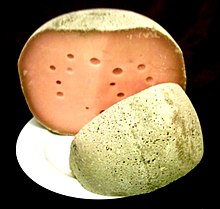Mimolette
The Mimolette is a spherical French cut cheese / hard cheese from cow's milk with at least 40% fat in the dry matter, which also known as Boule de Lille is known, which means "ball of Lille". This name refers to the in the town Lille located aging cellars , where about handball large originally matured up and down easily flattened cheese balls. The name Mimolette, on the other hand, comes from the French mimou , which means semi-soft. Presumably, the production of this cheese began in France in the 17th century using the Dutch Edam method, after the Minister Colbert banned the import of foreign goods. Today it is mainly made in the northernmost provinces of France ( Nord-Pas-de-Calais ), but there are also products from the Netherlands on the market.
The Mimolette ripens between two months and two years and has a typical, depending on age, mild-nutty to strong-spicy taste and a striking, intense yellow-orange to orange-brown color, darker towards the rind. The color is created by adding annatto (French roucou ), a vegetable dye from the seeds of the Orlean shrub ( Bixa orellana L. ); carrot juice is also used as a coloring agent for Dutch goods . The rind of young cheese is relatively smooth, with increasing age it becomes thicker and then resembles a lunar landscape strewn with craters. Mites , to which the cheese owes its holey surface, settle in the craters . The cheese batter is firm and a little brittle. Young Mimolette tastes relatively mild, when ripe the cheese smells strong, almost "medicinal". At this stage it tastes strongly hazelnut and fruity-lemony. Connoisseurs consider an age of 6-18 months to be optimal.
As an alternative to milder cheeses, Mimolette goes very well on a cheese platter . It is often eaten with black bread and gherkins or with classic French baguette . Since it is easy to grate, it can also be used in a variety of ways in warm cuisine.
In May 2013, US Customs banned the import of Mimolette cheese on the grounds that the Food and Drug Administration stated that the cheese was “whole or in part composed of a dirty, tainted, or rotten substance” “or otherwise unsuitable for food " be. This decision caused outrage in France. The cheese producers pointed out that “nobody has ever fallen ill from consuming Mimolette” and that a change in the production process would also lead to a change in taste.
Individual evidence
- ^ Import Refusal Report. US Food and Drug Administration, May 29, 2013, accessed July 5, 2014 ( "The article appears to consist in whole or in part of a filthy, putrid, or decomposed substance or be otherwise unfit for food." ).
- ↑ French outrage after US deems its cheese 'filthy'. BBC News, July 5, 2013, accessed July 6, 2013 .


